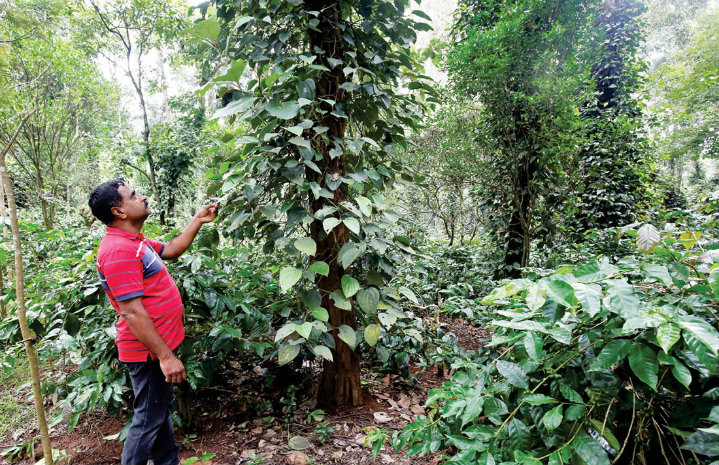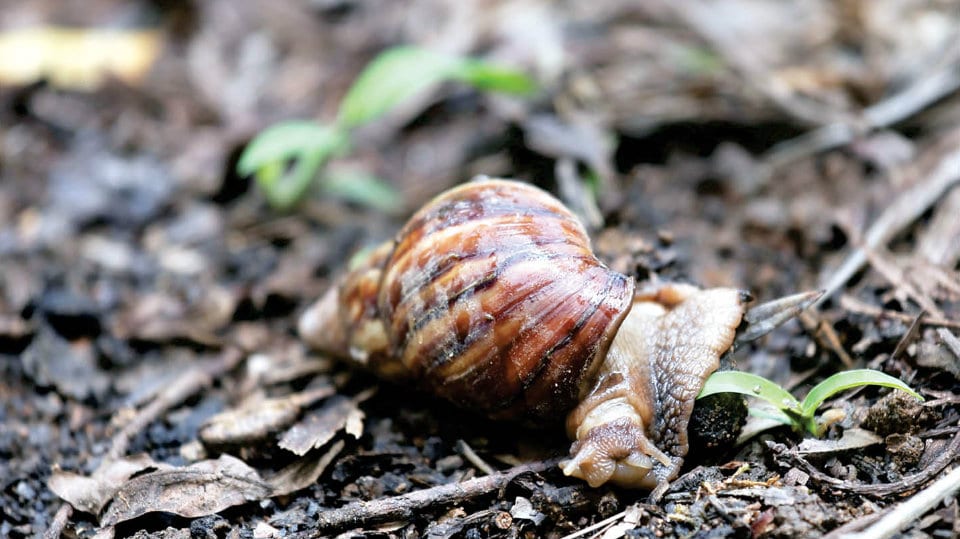Giant African land snails invade coffee estates in Kodagu; Coffee Board comes to growers’ rescue
By Arathi Menon
As monsoon clouds delayed their presence over the verdant hills of Kodagu in June this year, coffee planters of North Kodagu were caught in a bizarre tussle of apprehension and relief. A delayed monsoon is never good news for farmers in the Western Ghats who are increasingly finding themselves at the receiving end of climate change-induced extreme climatic events.
Last year, unprecedented rainfall and floods spelt doom for Kodagu farmers, taking lives and livelihoods away from them. On the other hand, rains are an open invitation to an invasive alien species of snail — the giant African land snail — that appeared in the Northern parts of Kodagu five-six years ago and has overstayed its welcome. It is a cause for concern for farmers of Shanivarsanthe in Somwarpet Taluk where the snails are gnawing their way through crops.
Easy adaptation
Farmer Pradeep B. Shekar, who owns 40 acres of coffee plantation, says that the pest goes for young coffee plants and tender leaves and stems of pepper, completely destroying the plants. A major crop pest, the snail is not a picky eater; it devours 500 plant species and easily adapts to different ecosystems. “They multiply in large numbers within a short span of time,” he says.
The giant African land snail, called Shanka (conch) Hula (worm) in local parlance for the conch-shaped shell it has, made its presence felt in Kodagu for the first time in 2012-2013 in 50-60 acres of coffee plantation in Shanivarsanthe.

Control measures fail
Many measures were taken to contain it but just when the farmers thought that they have expertly got rid of it, it reappeared unceremoniously in 2017, this time wreaking havoc in a 300-acre area, affecting crops of around 45 planters. The farmers here claim that they incur a loss of about Rs. 10,000 to Rs. 12,000 per acre, mostly from the additional cost put in to eliminate the pest.
The International Union for Conservation of Nature (IUCN) has listed the giant African land snail that goes by the scientific name Achatina Fulica as one of the worst invasive species in the world. The IUCN defines an Invasive Alien Species (IAS) as “a problematic species introduced outside its natural, past or present distribution. They may lead to changes in the structure and composition of ecosystems, detrimentally affecting ecosystem services, human economy and well-being.”
Alien species
Achatina Fulica is one of the four species of giant snails belonging to the gastropod family of Achatinidae that are native to Africa. It is classified as an obligate-outcrossing hermaphrodite, which means that one externally fertilised snail can establish a population.
Needless to say, they reproduce in large numbers. These snails begin laying eggs at six months of age and can lay around 100 eggs in their first year and up to 500 in the second year. Their life expectancy is around five years and one snail can lay up to 1,000 eggs by then. It is no surprise then that one giant snail, whose shell length ranges about 5 to 10 cm (though some adults may exceed 20cm) and a reported average weight of about 32 grams, can create a population all by itself.

Coffee Board comes up with effective bait
In successfully nipping a potential disaster in the bud, Kodagu Coffee Board has emerged as an unlikely hero. The researchers at the Central Coffee Research Institute in Balehonnur, Chikkamagaluru and the substation in Chettalli in Kodagu came up with bait for the snail for what they have termed as “the catch-and-kill method” of eliminating these snails. “The bait is made of rice bran, jaggery, castor oil and a chemical, Thiodicarb. These are mixed together and balls of it are placed between four coffee plants,” explains Vishwanath Hadagali, Junior Liaison Officer of Coffee Board at Shanivarsanthe.
The chemical used earlier was Methomyl which was also very effective but it was banned later as it was too strong for the soil. “We tried every method available in the literature to get rid of these pests and this bait was found to be the most effective,” says Manjunath Reddy, Assistant Entomologist, Coffee Research Substation at Chettalli. As a result, 30 tonnes of dead snails were collected in 2015.
Buying back dead snails
The Board also came up with a unique idea of buying back dead snails. While they started with Rs. 4 per kg, the buyback price stands at Rs. 8 per kg now. “The dead snails are disposed of in a pit that’s one-and-a-half feet deep. Salt is put over the dead ones to ensure even the last of the caught snails is dead and then buried,” Vishwanath says.
This meticulous burial is a precautionary measure against the spread of any disease by the snail. The giant African snails are known to serve as intermediate hosts of several parasites that cause severe diseases in pets, free-ranging vertebrates, and humans. They are perfect hosts of rat lungworm, Angiostrongylus cantonensis which causes Eosinophilic meningitis in human beings.
Research suggests that African snails can spread to new locations via trade routes, piggybacking on agricultural products, equipment, cargo and plant or soil matter. While there is no consensus on how they found their way into the pristine landscape of Kodagu, it is certain that these pesky visitors have come with no exit plan.
[This article first appeared on Mongabay. Photos by Abhishek N. Chinnappa]
Incentive to growers
Encouraged by this, the Coffee Board, with active participation from Karnataka Horticulture Department and Planters Association of Shanivarsanthe, upped their act through regular awareness meetings and distribution of bait kits to all the planters affected. A kit with a pair of gloves, 25kg of rice bran, 100g of Thiodicarb from the brand Larvin, 3 kg of jaggery and 100 ml castor oil, costs Rs. 1,000 which is distributed among farmers at a highly subsidised rate of Rs. 100. “This has to be a collective effort,” says Pradeep Kumar, an affected farmer from Handli village in Shanivarsanthe.
“If one affected farmer doesn’t participate, the infestation cannot be contained,” he adds. Vishwanath confirms 90 per cent success in eliminating these pests from Kodagu farms forever. “While we did not maintain records properly for the years 2014, 2015 and 2016, 24 tonnes of dead snails were collected in 2017 which came down to eight tonnes in 2018. We expect much lesser infestation this year,” Vishwanath says.








Recent Comments